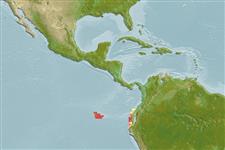>
Anguilliformes (Eels and morays) >
Myrocongridae (Atlantic red eels)
Etymology: Myroconger: Greek, myros, -ou = male of morey eel + Latin, conger = conger (Ref. 45335); nigrodentatus: Specific name refers to the internal dark pigment of the jaw and intermaxillary teeth.
Environment: milieu / climate zone / depth range / distribution range
Écologie
marin démersal; profondeur 50 - 250 m (Ref. 57763). Tropical
Eastern Pacific.
Taille / Poids / Âge
Maturity: Lm ? range ? - ? cm
Max length : 36.6 cm TL (female)
Description synthétique
Clés d'identification | Morphologie | Morphométrie
Rayons mous dorsaux (Total) : 298; Rayons mous anaux: 213; Vertèbres: 123. body rather robust, relatively short snout, teeth on intermaxillary, maxilla and dentary prominent and sharp, many with dark brown to black internal pigment; a single row of small teeth on vomer; a moderately large, almost horizontal slit-like branchial aperture; precaudal vertebrae 50.
Life cycle and mating behavior
Maturité | Reproduction | Frai | Œufs | Fécondité | Larves
Castle, P.H.J. and P. Béarez, 1995. Two new species of Myroconger (Anguilliformes, Myrocongridae) from the Pacific Ocean. Cybium 19(3):211-222. (Ref. 26785)
Statut dans la liste rouge de l'IUCN (Ref. 130435: Version 2024-2)
Menace pour l'homme
Harmless
Utilisations par l'homme
Pêcheries: sans intérêt
Outils
Articles particuliers
Télécharger en XML
Sources Internet
Estimates based on models
Preferred temperature (Ref.
123201): 13.7 - 14.8, mean 14.1 °C (based on 4 cells).
Phylogenetic diversity index (Ref.
82804): PD
50 = 0.5625 [Uniqueness, from 0.5 = low to 2.0 = high].
Bayesian length-weight: a=0.00102 (0.00046 - 0.00225), b=3.06 (2.88 - 3.24), in cm total length, based on all LWR estimates for this body shape (Ref.
93245).
Niveau trophique (Ref.
69278): 3.7 ±0.6 se; based on size and trophs of closest relatives
Fishing Vulnerability (Ref.
59153): Low to moderate vulnerability (27 of 100).
